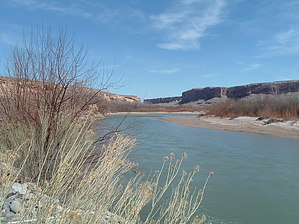
The southwest in general, and southern Utah in particular, is known for its profusion of prehistory. Anasazi ruins and rock art dot the landscape, from great National Parks and Monuments, to little, out of the way tiny sites that no one ever sees. Sand Island is sort of in between the two. It isn't part of some grand National Park like Zion or Mesa Verde. It also isn't a pile of rubble or two antelope scratched into a rock, someplace in the middle of nowhere. Sand Island is amazing. A cliff face stretching for a length of hundreds of feet above the San Juan River, and it is simply covered with petroglyphs. Some are very old, probably dating back thousands of years, while others were made much more recently; maybe as recently as the last 100 years by nomadic Utes. Sand Island has been used as a stopping ground, obviously, for many people for many hundreds of years.
From where you parked you car, look up at the cliff face looming to your north. Some of the images should reach out to you and be visible already. There is no defined trail really, leading up through the talus slope to the cliff. There are, however, several worn informal paths. Follow any one of these, and you'll soon find yourself at the base of the cliff where the images begin.
Some common images include bighorn sheep, both large and small. Bighorn sheep likely played a large role in the life of the local Anasazi as a source of food. A large herd of bighorn sheep now roams the San Juan River corridor, just downstream from Bluff. Other images include feet, snakes, and zig-zags. What do they mean? No one knows for sure. Perhaps the feet mean migration. The snakes could mean snakes. Or water. Or prayer. Or something else entirely. Some people think that the zig-zags are maps, specifically maps of the San Juan River. It could be. As you walk along the cliff face, come up with your own idea. Who knows, maybe you'll turn out to be right.
After you've seen as much of the cliff as you want, or if you're done with the main section, return to your vehicle by any path you can find. Other petroglyphs are present in the Sand Island area, and the intrepid explorer can usually locate some of them.
 Route Editor
Route Editor




